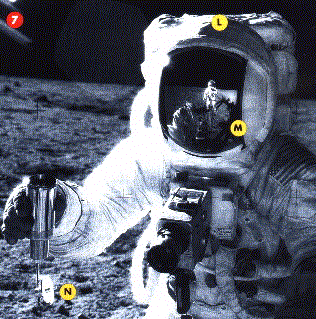
|
|
Fig. 1 - Apollo 12 lunar module pilot Alan Bean holds a
Special Environment Sample Collector. (NASA: AS12-49-7278,
annotations from X-Factor no. 2 (1997), pp. 44-46)
|
|
 Fig. 1, note L: A
picture taken from a chest camera shouldn't show the subject's
head.
Fig. 1, note L: A
picture taken from a chest camera shouldn't show the subject's
head.
It's difficult to identify the true "top" of a spherical object
viewed from any angle. In any photograph of a sphere there will
appear to be a top to it, which is simply the point on the sphere at
which the line of sight is tangent to it. This will be true for any
line of sight and any unobstructed sphere. To claim the spot at Note
L is necessarily the top of the helmet would require some other
reference, such as a feature on the helmet known to be at its apex.
 Fig. 1, note M: The
shadows that converge at the annotation are not parallel, as would be
the case if they were created by a single light source. Therefore
there must be multiple lights.
Fig. 1, note M: The
shadows that converge at the annotation are not parallel, as would be
the case if they were created by a single light source. Therefore
there must be multiple lights.
The conspiracists again rely on a rigidly naive expectation of
perfect objects casting perfect shadows on a perfectly smooth, flat
surface. The photographer (Pete Conrad) is shooting roughly up-sun, so whatever's casting those
shadows should be in the picture. Closely examining the shadows behind
Conrad, we see that they also converge because they are the shadows of
Conrad's legs. The shadows converge because Conrad's legs converge --
at his hips. Similarly the shadows in question at Note M are being
cast by Bean's legs, which also converge at his hips.
Two light sources do not cast such converging shadows. They cast
overlapping shadows with two levels of brightness.
With the supposed multiple light sources, we wonder why there's
only one highlight on Bean's visor.
 Fig. 1, note N: The
shaded side of the Special Environmental Sample Container shouldn't be
brightly lit. This proves that additional lighting was used in the
lunar surface photographs.
Fig. 1, note N: The
shaded side of the Special Environmental Sample Container shouldn't be
brightly lit. This proves that additional lighting was used in the
lunar surface photographs.
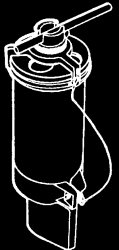
|
|
Fig. 2 - Engineering illustration of the sample
container with the lid fastened. The lid was connected to the
container by a wire to prevent it from being dropped and
lost. (Courtesy Union Carbide)
|
|
|
Fig. 2 is a diagram of the Special Environmental Sample Container
(SESC) provided by its manufacturer. The disk-shaped object hanging
below the barrel of the device in Fig. 3 is the lid, shown closed in
the diagram. Although it appears suspended from the metal bar, it is
actually hanging from the thin wire seen in the diagram. The metal
rod attached to the lid is to make it easier to close the lid while
wearing space suit gloves.
In Fig. 4 we see a SESC photographed in the laboratory during
testing. You can see that the underside of the lid is polished metal
and therefore quite reflective. The fastener holding the clamp
mechanism and the clamps themselves are clearly reflected in the lid
surface.
From Fig. 3 we see that the lid is hanging at an angle likely to
reflect the brightly lit portion of Bean's suit. Conspiracists argue
that the disk is being brightly lit by another light source. But
there's no corresponding highlight on the cylindrical barrel of the
tool, and Bean's glove is clearly lit only from above and behind.
Therefore the postulated light source illuminating the SESC lid must
be very narrow in order to shine brightly on the lid but completely
miss objects only a few inches away.
The conspiracist hypothesis is at best an ad hoc explanation. The
conspiracist is drawn toward potential explanations which suggest a
hoax, and so makes this argument regardless of whether it's a
reasonable or practical thing to do. We struggle to find a reason why
a photographer trying to hoax a lunar surface photograph would go to
such paintstaking trouble to arrange a light to shine only on a
particular piece of equipment. And by doing so he must surely know
that he's introducing a detail that would tend to reduce the
authenticity of the photograph. Faced with this dilemma, the
conspiracist postulates the Whistle-Blower Theory.
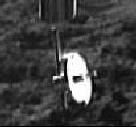
|
|
Fig. 3 - Closeup of the dangling lid. (NASA:
AS12-49-7278)
|
|
|
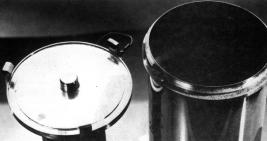
|
|
Fig. 4 - The sample container photographed in a Union
Carbid laboratory. The polished lid clearly reflects
light. (NASA: S88-52666, from Union Carbide photo
137774)
|
|
|
 I've seen a version of
this photograph that includes another astronaut in the visor
reflection. That's proof it was all done on a soundstage.
I've seen a version of
this photograph that includes another astronaut in the visor
reflection. That's proof it was all done on a soundstage.
That version, shown in Fig. 5, is a forgery, and not even a very
good one.
First, we know who did it and why. David Harland created it as a
joke. It wasn't meant to be taken seriously.
Second, it's very obvious how it was created. The object at the
extra astronaut's feet is the distinctive three-armed magnetometer
from the ALSEP. If we search through
all the photographs of the ALSEP magnetometer from Apollo 12, we find
one of Al Bean that's a perfect match for the extra astronaut in the
visor.
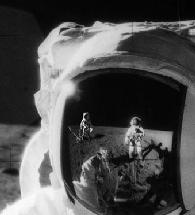
|
|
Fig. 5 - A fanciful version of the photograph created
by David Harland. (Apollo Lunar Surface Journal)
|
|
|
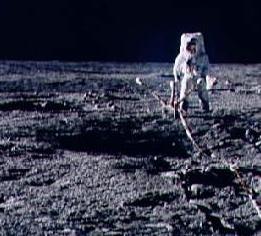
|
|
Fig. 6 - The image David Harland used to provide an
"extra" astronaut in Bean's visor. (NASA: AS12-46-6813)
|
|
|
Compare the image in Bean's visor with the image of Conrad
standing next to the magnetometer in Fig. 6.










 Fig. 1, note L: A
picture taken from a chest camera shouldn't show the subject's
head.
Fig. 1, note L: A
picture taken from a chest camera shouldn't show the subject's
head.





